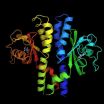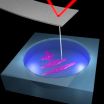(Press-News.org) MAYWOOD, Il. -- Loyola University Chicago researchers are taking advantage of a quirk in the evolution of fruit fly genes to help develop new weapons against cancer.
A newly discovered fruit fly gene is a simplified counterpart of two complex human genes that play important roles in the development of cancer and some birth defects. As this fruit fly gene evolved, it split in two. This split has made it easier to study, and the resulting insights could prove useful in developing new cancer drugs.
"Evolution has given us a gift," said Andrew K. Dingwall, PhD, senior author of a paper that describes how his team identified and analyzed the split gene. Their findings are published in the June issue of the prestigious journal Development. Based on the importance of the findings, the paper was recently selected as an "Editor's Choice" in Science Signaling, published by the American Association for the Advancement of Science (AAAS).
When normal cells develop, they differentiate into particular types, such as bone cells or muscle cells, and reproduce in an orderly manner. The process is governed by genes and hormones that work in concert. Two of these genes are known as MLL2 and MLL3. Cancer cells, by contrast, undergo uncontrolled division and reproduction.
Since 2010, a growing number of cancers have been linked to mutations in the MLL2 and MLL3 genes. These cancers include non-Hodgkin's lymphoma, colorectal cancer, kidney cancer, bladder cancer and a brain tumor called medulloblastoma. There also is evidence that MLL2 and MLL3 mutations are involved in breast and prostate cancers.
The MLL2 and MLL3 genes are similar to one another. Each has more than 15,000 building blocks called base pairs -- more than 10 times the number found in a typical gene. Because these genes are so large and complex, they are difficult to study.
In the fruit fly, the counterpart gene to MLL2 and MLL3 split into two genes named TRR and CMI. Each carried information critical for normal gene regulation, and they wound up on different chromosomes. The parsing of the MLL2/MLL3 genetic information into smaller genes in the fruit fly made study of the gene functions much easier; it allowed the researchers unprecedented opportunities to explore the role the human genes play in the development of cancers.
"This fruit fly gene gives us unique insight into the massive human MLL2 and MLL3 genes that are almost impossible to study because they are so large," Dingwall said.
Dingwall's team studied the function of the fruit fly gene by inducing various mutations and then observing the effects on the flies. This will lead to better understanding of what goes wrong when mutations in MLL2 and MLL3 genes trigger the uncontrolled reproduction of cancer cells in humans. This in turn could help researchers develop drugs that would redirect cancer cells to differentiate into normal cells, Dingwall said.
INFORMATION:
The study was funded through a grant from the National Science Foundation, with additional support from the National Institutes of Health.
Dr. Dingwall is an associate professor in the Oncology Institute and Department of Pathology at Loyola University Chicago Stritch School of Medicine. Co-authors are Claudia Zraly, PhD (joint first author and senior co-author); Chhavi Chauhan (joint first author); Megan Parilla; and Manuel Diaz, MD.
END
In the battle against HIV/AIDS conditions on the frontlines are constantly in flux as treatment, research and policy evolve. The landmark HIV Prevention Trials Network (HPTN) 052 study, which established that antiretroviral treatment in people who are HIV positive decreases the likelihood of transmitting HIV to their sexual partners, was no exception. One year after publication the study serves as a case study of ethical challenges faced at every stage of the research trial process in the new paper "Establishing HIV treatment as prevention in the HIV Prevention Trials ...
EUGENE, Ore. -- (June 14, 2012) -- University of Oregon scientists have discovered how the bacterium Helicobacter pylori navigates through the acidic stomach, opening up new possibilities to inactivate its disease-causing ability without using current strategies that often fail or are discontinued because of side effects.
Their report -- online ahead of regular publication July 3 in the journal Structure -- unveils the crystal structure of H. pylori's acid receptor TlpB. The receptor has an external protrusion, identified as a PAS domain, bound by a small molecule called ...
Soaring numbers of older, sicker prisoners are causing an unprecedented health care challenge for the nation's criminal justice system, according to a new UCSF report.
As the American penal system confronts a costly demographic shift toward older prisoners, the authors call for an overhaul in health care practices for elderly inmates who disproportionately account for escalating medical expenses behind bars. The recommendations include screening for dementia among prisoners, improved palliative care, and standard policies for geriatric housing units for infirm inmates.
The ...
Energy efficiency is the most significant challenge standing in the way of continued miniaturization of electronic systems, and miniaturization is the principal driver of the semiconductor industry. "As we approach the ultimate limits of Moore's Law, however, silicon will have to be replaced in order to miniaturize further," said Jeffrey Bokor, deputy director for science at the Molecular Foundry at the Lawrence Berkeley National Laboratory and Professor at UC-Berkeley.
To this end, carbon nanotubes (CNTs) are a significant departure from traditional silicon technologies ...
Visual and auditory stimuli that elicit high levels of engagement and emotional response can be linked to reliable patterns of brain activity, a team of researchers from The City College of New York and Columbia University reports. Their findings could lead to new ways for producers of films, television programs and commercials to predict what kinds of scenes their audiences will respond to.
"Peak correlations of neural activity across viewings can occur in remarkable correspondence with arousing moments of the film," the researchers said in an article published in the ...
An international team of researchers' study of the spatial patterns of the spread of obesity suggests America's bulging waistlines may have more to do with collective behavior than genetics or individual choices. The team, led by City College of New York physicist Hernán Makse, found correlations between the epidemic's geography and food marketing and distribution patterns.
"We found there is a relationship between the prevalence of obesity and the growth of the supermarket economy," Professor Makse said. "While we can't claim causality because we don't know whether obesity ...
CHAMPAIGN, Ill. — Experienced anglers know that choppy waters make for difficult fishing, so they try not to rock the boat. Thanks to a new microscopy technique, cell biology researchers can heed that same advice.
University of Illinois researchers developed a method they call "trolling AFM," which allows them to study soft biological samples in liquid with high resolution and high quality. Led by mechanical science and engineering professor Min-Feng Yu, the group published its findings in the journal Nanotechnology.
"We developed a highly sensitive method for high-resolution ...
(Boston) – A recent study conducted by researchers at Boston Medical Center (BMC) shows that patients receiving "take home" methadone maintenance treatment (MMT) were less likely to be admitted to the hospital as compared to those not receiving take home doses. The findings, which are published online in the Journal of Addiction Medicine, demonstrate the potential benefits of successful addiction treatment, including better overall health and decreased health care utilization.
This research was led by Alexander Walley, MD, MSc, physician in general internal medicine at ...
Nine out of 10 Californians under the age of 65 will be enrolled in health insurance programs as a result of the Patient Protection and Affordable Care Act (ACA), according to a joint study by the UC Berkeley Center for Labor Research and Education and the UCLA Center for Health Policy Research.
Between 1.8 million and 2.7 million previously uninsured Californians will gain coverage by 2019, when the law's effect is fully realized, the researchers said.
The report, which uses a sophisticated computer simulation model to project the ACA's impact on insurance coverage, ...
PHILADELPHIA—It has long been known that cancer is a disease of aging, but a molecular link between the two has remained elusive.
Now, researchers at the Kimmel Cancer Center at Jefferson (KCC) have shown that senescence (aging cells which lose their ability to divide) and autophagy (self-eating or self-cannibalism) in the surrounding normal cells of a tumor are essentially two sides of the same coin, acting as "food" to fuel cancer cell growth and metastasis.
Michael P. Lisanti, M.D., Ph.D., Professor and Chair of Stem Cell Biology and Regenerative Medicine at Jefferson ...



